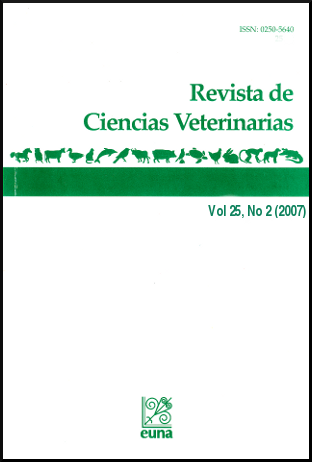Detección de enfermedades en abejas africanizadas en Costa Rica
Keywords:
acariosis, nosemiasis, varroosis, abejas africanizadas, prevalencia, muestreo nacional, Acariosis, Nosemiasis, Varroosis, Africanized honey bees, prevalence, national sampleAbstract
Losreportes sobre la presencia de enfermedades en abejas africanizadas en Costa Rica s son escasos. Si bien es cierto se han realizado estudios para determinar su prevalencia, la información ha sido aislada y de poca trascendencia. En este estudio, se determinó la prevalencia de las principales enfermedades que afectan a las abejas adultas en Costa Rica, realizando un muestreo a nivel nacional entre los meses de Agosto-Diciembre de 2006. Se analizaron, mediante técnicas de laboratorio, 262 muestras de abejas adultas, pertenecientes a 129 apicultores, y provenientes de San José, Puntarenas, Guanacaste, Cartago y Alajuela. Se determinó una alta prevalencia de varroosis (42.0%) y nosemiosis (28.0%); mientras que únicamente un 1.1% de las muestras fue positiva para acariosis. Un 49.0% (n= 110) de las muestras positivas a Varroa, presentó un nivel de infestación leve, mientras que un 18.2% presentó un nivel fuerte (superior al 10.0%). La mayor prevalencia de Nosema correspondió al mes de Noviembre; mientras que acariosis se diagnóstico únicamente en Acosta, Orotina y Santa María de Dota.
ABSTRACT
There are few reports concerning the occurrence of adult bee diseases in africanized bees in Costa Rica. In our study, conducted between August and December 2006, 262 AHB colonies belonging to 129 beekeepers from different geographic areas of Costa Rica were randomly sampled for nosemiasis, acariosis and varroosis. Most adult bees samples were taken from colonies not suffering from symptoms of any disease and collected from the broodnest of each colony. Based on our data, we can indicate that 42.0% and 28.0% of the samples were positive to Varroa mites and nosemiasis, respectively. A low prevalence of acariosis was found. Most of the samples positive to Varroa (n=110) showed a low mite infestation level, whereas 18.2 % had a high level. The prevalence of nosemiasis disease was greater in November. Only in Acosta, Orotina and Santa María de Dota, we found the presence of acariosis. These results provide a clear evidence of a high prevalence of Nosema disease and varroa mites and the low presence of acariosis in africanized bees in Costa Rica.
Downloads
Published
How to Cite
Issue
Section
License
Licensing of articles
All articles will be published under a license:

Licencia Creative Commons Atribución-NoComercial-SinDerivadas 3.0 Costa Rica.
Access to this journal is free of charge, only the article and the journal must be cited in full.
Intellectual property rights belong to the author. Once the article has been accepted for publication, the author assigns the reproduction rights to the Journal.
Ciencias Veterinarias Journal authorizes the printing of articles and photocopies for personal use. Also, the use for educational purposes is encouraged. Especially: institutions may create links to specific articles found in the journal's server in order to make up course packages, seminars or as instructional material.
The author may place a copy of the final version on his or her server, although it is recommended that a link be maintained to the journal's server where the original article is located.
Intellectual property violations are the responsibility of the author. The company or institution that provides access to the contents, either because it acts only as a transmitter of information (for example, Internet access providers) or because it offers public server services, is not responsible.







